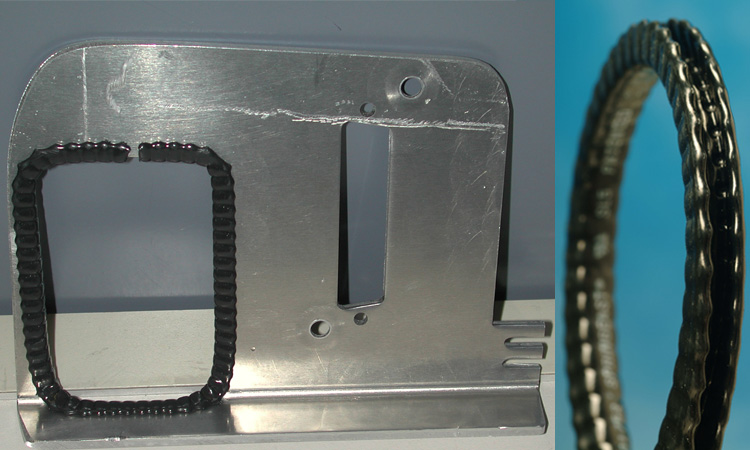Protection solutions for rail electronics
Durable edge protection for use in trains protects cables from damage and can be installed in seconds without adhesives
Durable edge protection for use in trains protects cables from damage and can be installed in seconds without adhesives
Modern trains are full of communication technology in order to exchange information between the individual on-board systems and the outside world. The extensive network of cables is hidden in walls, floors and ceilings, sometimes in very confined spaces. The cables pass sharp edges, which, if inadequately protected, can cause cracks and lead to a short circuit – with fatal consequences such as data loss, system failures or fires. Therefore, a hard-wearing material is required, which protects the cables sufficiently without being affected by abrasion, vibrations, or extreme temperature fluctuations. Device Technologies (DTi) has therefore developed an edge protection especially designed for use in trains, which is particularly durable and can also be attached by simply plugging it on without the use of adhesives. In this way, productivity can be increased as fewer work steps are required and additional costs, such as for adhesives, are eliminated reducing install costs by up to 49 per cent. The steel reinforced SL-FST is also heat and flame resistant. As a result, the variant meets the high requirements of the European rail industry, including EN45545 or FST / UV exposure. The material was initially used in the aviation industry and has proven itself in environments with high vibration levels, making it ideal for use in high-speed trains and other rail applications.

Driver’s cab, passenger monitors, train-land communication interfaces or automatic door control: these are just a few examples of on-board systems in trains that need to communicate with each other to ensure smooth train operations. As a result, modern trains are becoming more and more high-performance computers on wheels, whose most important lifelines – the connecting cables between the individual electronic components and signaling devices – must pass through sharp edges and narrow transitions.“If the cables are damaged, for example by continuous abrasion, short circuits can occur, which in the worst case can paralyze a critical system such as the brakes or cause a fire, ” explains Meike Kurzak, Managing Partner of DTi GmbH. “But data loss or faulty signal control can also occur because of abrasion damage. In addition, these cables are laid in very confined spaces with very little play and are also sometimes subject to high vibration or temperature fluctuations. For this reason, the edges to be passed are equipped with a special edge protection, which previously had to be applied with the use of adhesives in a time-consuming process. Especially in case of fire, the nylon grommets themselves which when combined with the adhesives can cause an increased toxic load and smoke development. For this reason, DTicustomized its leading grommet edging solution Spring-Fast by optimizing it to meet the needs of rail transport. The SL-FST edge protection consists of a particularly hard-wearing, non-flammable and steel-reinforced special thermoplastic, so that in the event of a fire it does not burn further or produce additional toxic smoke. Compared to conventional plastic edge protection, this material also cannot dry out or become porous, even if it is exposed to extreme changes and temperatures.
Non-flammable material minimizes potential hazards
“The SL-FST consists of a stainless-steel core that is completely encapsulated in a halogen-free and low-toxic thermoplastic compound,” explains Kurzak. “This special material is flame-retardant and particularly corrosion-resistant. Because of its properties, the plastic edge protection normally used in the rail industry is more likely to dry out and become brittle if exposed to heat or cold for long periods of time. It can break under sufficient pressure, stress or vibration.” The special composition of SL-FST makes it very resistant to these extreme temperature fluctuations. As a result, the edge protector can be attached to the train both inside and outside. Even the high vibrations occurring on high-speed lines can be absorbed by the special construction of a securely fitting steel core and resistant plastic. SL -FST is designed with a steel core with castles, or gripping teeth, that angle into the edge creating edge retention without adhesives. DTi’s engineers have used their experience from aviation to develop the SL-FST, as the material has to perform under extreme speeds, G-forces and vibration environments in aircraft. “As more and more high-speed lines are being laid for trains in Europe, this synergy was a logical step in the development process,” Kurzak reports.

In particular, the performance of the material in contact with fire was a key factor in its adaptation to the European railway sector: “As many sections of track run through tunnels, fire safety requirements are particularly high in Europe,” explains Kurzak. “We have therefore optimized the plastic so that in terms of flammability and toxicity it does not add to the smoke and fire development, as would be the case with a plastic that contains questionable additives or is attached with adhesives.”In practice this means that in a fire the SL-FST will not support combustion, burn insignificantly, and will only produce a very small, insignificant amount of smoke. As a result, the material meets the strict requirements of DIN EN 45545-2 and is qualified for Hazard Levels 2 and 3, which are the highest material-technical requirements within the framework of this DIN.
Easy assembly without adhesives increases productivity and protects workers
The SL-FST can be installed completely without adhesives with just a few finger movements. This minimizes the production or set-up time from several minutes to a few seconds. As a result, productivity can be increased enormously because the same amount of parts can be installed in a fraction of the time normally required. This even leads to an overall cost reduction of up to 49 percent compared to adhesive-based plastic variants, as less working time and costs are required for the additional steps and materials that would otherwise be necessary. To achieve this, the edge protector simply has to be pushed on along the shape of the edge and pressed firmly into place. The SL-FST castles lock automatically and provide strong edge retention. Nevertheless, the protection can be easily removed again. Since no adhesives are used, workers are no longer exposed to toxic chemicals (VOCs) and odours and do not have to wear gloves or masks when attaching the edge protection. “Adhesives and other solvents must be specially stored and disposed of and must be identified there by warning notices. Since the SL-FST installs completely without this, it is much more pleasant to work with and at the same time it becomes a very green alternative to what is being used now,” concludes Kurzak.
Further information visit: www.dti-devicetech.eu
POWERTECH REVIEW provides cognitive exchange of information on the power sector, which will facilitate you keep updated on a real time basis.
Please follow our magazine page and also join our LinkedIn Group- exclusive group created for manufacturing professionals community
Join us on LinkedIn Group : https://www.linkedin.com/groups/10476643/
Follow us on LinkedIn : https://www.linkedin.com/company/powertech-review/

